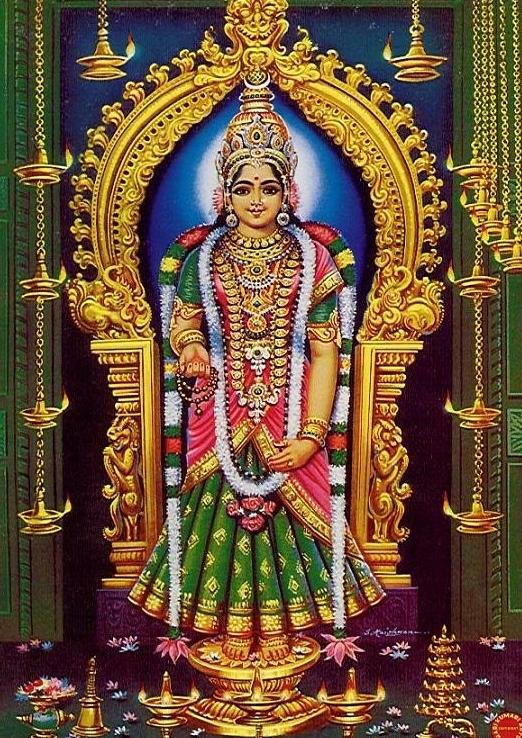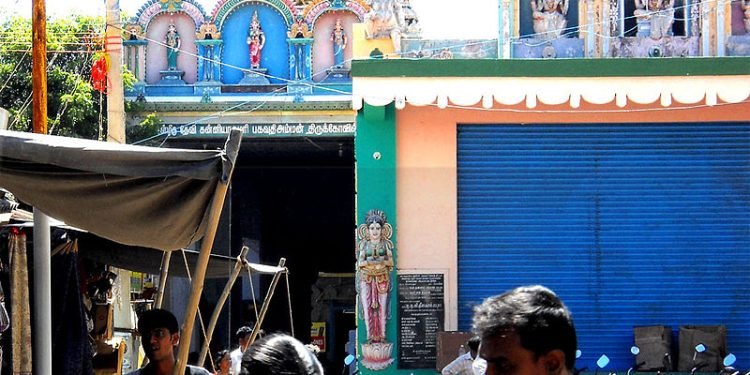Kanyashram Shakthi Peeth is the place where the back of Devi Sati fell. Here Devi Sati is worshipped as Sharwani or Narayani and Lord Shiva as Nimish. Kanyashram is also known as Kalikashram or Kanyakumari Shakthi Peeth.
Shrine’s History
The worship of Devi Kanya Kumari dates back to the Vedic times. She has been mentioned in Ramayana, Mahabharata, and the Sangam works Manimekalai, Puranaanooru and Nārāyaṇa Upanishad, a Vaishnava Upanishad in the Taittiriya Samhita of Krishna Yajur Veda. As directed by his Guru Sri Ramakrishna Paramahamsa, Swami Vivekananda, came here to seek Devi’s blessing in December 1892, as Devi is the goddess of Sanyasa.
It is in this location he decided to embark on the Missionary Work to a higher level of action rather than being passive like the usual Sanyasis’. Swami Brahmananda (1863?1922) and Swami Nirmalananda (1863?1938), another two disciples of Sri Ramakrishna Parama-hamsa also worshipped Devi Kanyakumari. In fact, Swami Nirmalananda brought several small girls from many parts of Kerala to worship Bahagavathy in 1935-36 period. To the surprise of all, seven girls later became the members of the first batch of Nuns of the “Sarada Ashrama”, a Hindu Nunnery started later in 1948 in Ottapalam, Palakkad, Kerala by Swami Vishadananda.
The rites and rituals of the temple are organised and classified by following Sankaracharya’s treatise. The author of Periplus of the Erythraean Sea has written about the prevalence of the propitiation of the deity Kanyakumari in the extreme southern part of India; “There is another place called Comori and a harbour, either come to those men who wish to consecrate themselves for the rest of their lives, and bath and dwell in celibacy and women also do the same; for it is told that a goddess once dwelt here and bathed.” Kanyakumari was under the rule of the Paravar Kings[citation needed] till the downfall of Pandyas, and later by kings of Travancore under the overall suzerainty of the British until 1947, when India became independent. Travancore joined the independent Indian Union in 1947. Later in the state partition, Kanyakumari became part of Tamil Nadu.

Legends Associated with This Shrine
The mythological story dates back in the Vedic period. Bana an asura by birth was the ruler of his land. He was a very powerful king. He took penance and obtained a boon from Lord Brahma that his death will only be with the hand of an adolescent virgin girl. With this powerful boon, he became fearless and wreaked havoc on the entire world. He went to conquest and oust Lord Indra from his throne. He banishes all the devas from there. They veiled themselves from the universe. The devas who were the personification of the basic natural elements, Agni (fire), Varuna (water), Vayu (air) went uncoordinated and havoc spread in the universe, As Indra was not able to administer and coordinate the Pancha bootha. Bhagavathy, the unbiased Prakriti, will only balance the nature; she does not favour or bias, as she itself is the nature where all living beings is a part of.
Bhagavathy manifested herself in the Southern tip of the Aryavartha, to kill Bana and recur the balance of nature. As an adolescent girl, she had immense devotion towards Lord Shiva. The Lord decided to marry her. All arrangements were made for the marriage. Lord Shiva started the journey from Shuchindram for the marriage. Sage Narada realised Bana could only be killed by a virgin girl and interrupted Shivas marriage with Bhagavathy, The marriage mahurat was in the Brahma-muhurta early in the morning. Narada made the sound of a cock and send wrong information that the Sun has already risen and the auspicious time passed. The marriage procession returned. The poor Devi waited for the Lord and finally she thought that she has been snubbed. With unbearable insult, pain, grief and anger she destroyed everything she saw.
She threw away all the food and broke her bangles. When she finally gained her composure she chooses to be a Sanyasin forever and took penance. Ages later Bana, tried to lure and approach the goddess without realising who she was. The infuriated Bhagavathy, who was the Bhadrakali herself, slaughtered Bana at once. Moments before his death Bana realised that the one before him is the Bhagavathy, the Almighty itself. He prayed her to absolve him of his sins. Bhagavathy maintained her divine presence in the place, in the Devi Kanyakumari Temple
Architectural Relevance of This Shrine
The architecture of the temples, including the Bhagvati temple, in Kanyakumari, has influences of the rulers like the Cholas, the Cheras, the Nayaks and the Pandyas. One of the reasons is that the town was ruled, at different times, by the dynasties of the above rulers. The architecture is based on delicate craftsmanship and intricate designs. The work seems like a piece of jewellery where the design is carved intricately. The architecture of the temples at Kanyakumari also has Dravidian influences. It was in the influence Dravidian art forms that gopurams or the east ? west towers of the Bhagvati temples have been built. It is the intricate workmanship on huge gopuram like structures is what makes the architecture of the Bhagvati temple known all around the world.
Shrine’s Map Location and How to Go There
By Road
Road Ways: Kanyakumari is connected by road to all places in South India. Some of the places are: 87 km from Trivandrum.19 km from Nagercoil.85 km from Tirunelveli.133 km from Tuticorin.314 km from Rameswaram.235 km from Madurai.
By Rail
Nearest Railway Station: Kanyakumari is connected to Trivandrum, Delhi and Mumbai by broad gauge. Tirunelveli (85 km) is the other nearest railway junction which can be reached by road via Nagercoil (19 km)
By Air
Nearest Airport: : Trivandrum (87 kms)
Shrine Timings
The temple is opened for darshan from 6.00 a.m. to 11.00 a.m. and 4.00 p.m. to 8.00 p.m.
Events Celebrated at This Shrine
Chaitra Pournima Festival: on the Full moon day in May Navarathri festival: 9 day festival in (SeptemberOctober). The music artists get an opportunity to offer their artistic skill to the devi by performing in the Navarathri Mandapam.
Vaisakha festival: the 10-day festival in MayJune culminating by a Thoni Ezhunellathu in MayJune. During this festival, Devi will be taken in procession both in the morning and evening, during Aaraatu the eastern door is opened. On a ninth day, the Thoni Ezhunellathu takes place. Devi will be taken around the water on the western part in a boat.
Kalabham festival: The idol is smeared in Sandal paste in the last Friday of the month of Karkidaka or Aadi, in JulyAugust.













































